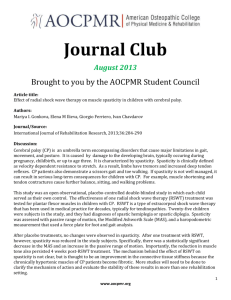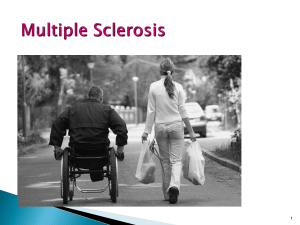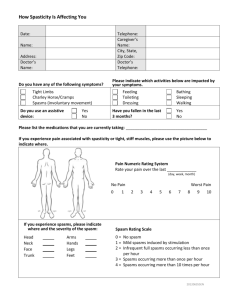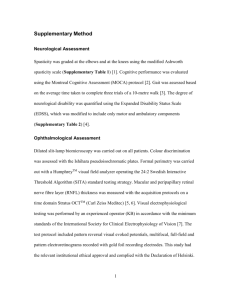Document 10290790
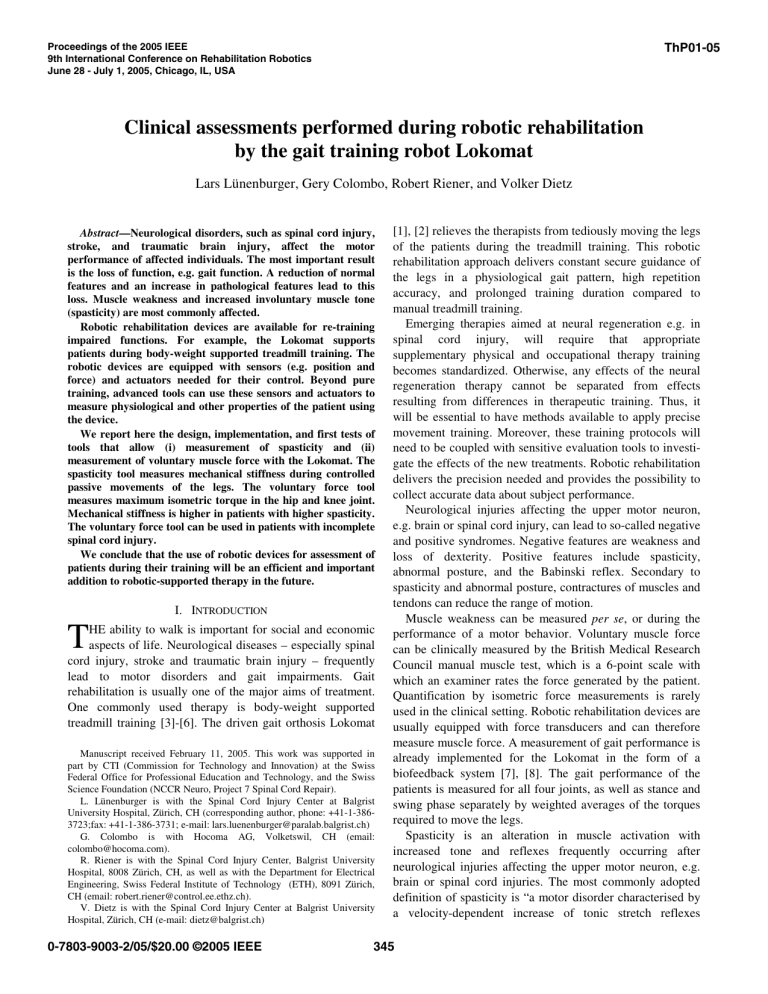
ThP01-05 Proceedings of the 2005 IEEE
9th International Conference on Rehabilitation Robotics
June 28 - July 1, 2005, Chicago, IL, USA
Clinical assessments performed during robotic rehabilitation by the gait training robot Lokomat
Lars Lünenburger, Gery Colombo, Robert Riener, and Volker Dietz
Abstract —Neurological disorders, such as spinal cord injury, stroke, and traumatic brain injury, affect the motor performance of affected individuals. The most important result is the loss of function, e.g. gait function. A reduction of normal features and an increase in pathological features lead to this loss. Muscle weakness and increased involuntary muscle tone
(spasticity) are most commonly affected.
Robotic rehabilitation devices are available for re-training impaired functions. For example, the Lokomat supports patients during body-weight supported treadmill training. The robotic devices are equipped with sensors (e.g. position and force) and actuators needed for their control. Beyond pure training, advanced tools can use these sensors and actuators to measure physiological and other properties of the patient using the device.
We report here the design, implementation, and first tests of tools that allow (i) measurement of spasticity and (ii) measurement of voluntary muscle force with the Lokomat. The spasticity tool measures mechanical stiffness during controlled passive movements of the legs. The voluntary force tool measures maximum isometric torque in the hip and knee joint.
Mechanical stiffness is higher in patients with higher spasticity.
The voluntary force tool can be used in patients with incomplete spinal cord injury.
We conclude that the use of robotic devices for assessment of patients during their training will be an efficient and important addition to robotic-supported therapy in the future.
I. I NTRODUCTION
T HE ability to walk is important for social and economic aspects of life. Neurological diseases – especially spinal cord injury, stroke and traumatic brain injury – frequently lead to motor disorders and gait impairments. Gait rehabilitation is usually one of the major aims of treatment.
One commonly used therapy is body-weight supported treadmill training [3]-[6]. The driven gait orthosis Lokomat
Manuscript received February 11, 2005. This work was supported in part by CTI (Commission for Technology and Innovation) at the Swiss
Federal Office for Professional Education and Technology, and the Swiss
Science Foundation (NCCR Neuro, Project 7 Spinal Cord Repair).
L. Lünenburger is with the Spinal Cord Injury Center at Balgrist
University Hospital, Zürich, CH (corresponding author, phone: +41-1-386-
3723;fax: +41-1-386-3731; e-mail: lars.luenenburger@paralab.balgrist.ch)
G. Colombo is with Hocoma AG, Volketswil, CH (email: colombo@hocoma.com).
R. Riener is with the Spinal Cord Injury Center, Balgrist University
Hospital, 8008 Zürich, CH, as well as with the Department for Electrical
Engineering, Swiss Federal Institute of Technology (ETH), 8091 Zürich,
CH (email: robert.riener@control.ee.ethz.ch).
V. Dietz is with the Spinal Cord Injury Center at Balgrist University
Hospital, Zürich, CH (e-mail: dietz@balgrist.ch)
[1], [2] relieves the therapists from tediously moving the legs of the patients during the treadmill training. This robotic rehabilitation approach delivers constant secure guidance of the legs in a physiological gait pattern, high repetition accuracy, and prolonged training duration compared to manual treadmill training.
Emerging therapies aimed at neural regeneration e.g. in spinal cord injury, will require that appropriate supplementary physical and occupational therapy training becomes standardized. Otherwise, any effects of the neural regeneration therapy cannot be separated from effects resulting from differences in therapeutic training. Thus, it will be essential to have methods available to apply precise movement training. Moreover, these training protocols will need to be coupled with sensitive evaluation tools to investigate the effects of the new treatments. Robotic rehabilitation delivers the precision needed and provides the possibility to collect accurate data about subject performance.
Neurological injuries affecting the upper motor neuron, e.g. brain or spinal cord injury, can lead to so-called negative and positive syndromes. Negative features are weakness and loss of dexterity. Positive features include spasticity, abnormal posture, and the Babinski reflex. Secondary to spasticity and abnormal posture, contractures of muscles and tendons can reduce the range of motion.
Muscle weakness can be measured per se , or during the performance of a motor behavior. Voluntary muscle force can be clinically measured by the British Medical Research
Council manual muscle test, which is a 6-point scale with which an examiner rates the force generated by the patient.
Quantification by isometric force measurements is rarely used in the clinical setting. Robotic rehabilitation devices are usually equipped with force transducers and can therefore measure muscle force. A measurement of gait performance is already implemented for the Lokomat in the form of a biofeedback system [7], [8]. The gait performance of the patients is measured for all four joints, as well as stance and swing phase separately by weighted averages of the torques required to move the legs.
Spasticity is an alteration in muscle activation with increased tone and reflexes frequently occurring after neurological injuries affecting the upper motor neuron, e.g. brain or spinal cord injuries. The most commonly adopted definition of spasticity is “a motor disorder characterised by a velocity-dependent increase of tonic stretch reflexes
0-7803-9003-2/05/$20.00 ©2005 IEEE 345
controlled displacement.
The aim of this project is to design, implement, and test tools for the robotic rehabilitation device, Lokomat, that assess spasticity and voluntary muscle force.
II. M ETHODS
A. Lokomat
The Lokomat® (Hocoma AG, Volketswil, Switzerland) is a bilateral robotic orthosis that is used in conjunction with a treadmill and a dynamic body weight support to control a patient’s leg movements in the sagittal plane (Fig. 1). The
Lokomat’s hip and knee joints are actuated by linear backdrivable actuators integrated into an exoskeletal structure.
Passive foot lifters assist ankle dorsiflexion during the swing phase. The legs of the patient, which are fixed to the exoskeleton by straps, are moved according to a position control strategy with predefined hip and knee joint trajectories.
B. Spasticity measurement
Fig. 1. The Lokomat® is a driven gait orthosis with electromechanical drives for hip and knee joint (2 degrees of freedom per leg) [1, 2].
(With permission of Hocoma AG, Volketswil, Switzerland)
(muscle tone) with exaggerated tendon jerks, resulting from hyperexitability of stretch reflexes” [9]. More recent definitions [10], [11] emphasize some aspects differently.
Generally, spasticity leads to an increase in mechanical resistance of a joint during passive movements.
Spasticity can affect motor control in a negative way leading to unwanted movements or preventing intended movements. However, in some cases patients actively rely on their spasticity to support their voluntary muscle activation, e.g. to extend the legs while standing [12]. These factors make a sensitive measurement of spasticity a prerequisite for any therapeutic treatment that modifies spasticity.
Methods for spasticity assessment can be classified as clinical, biomechanical, or neurophysiological (for review see [13]-[15]). The most commonly used clinical test is the
Ashworth test [16] and its modification by Bohannon and
Smith [17]. In these tests an examiner moves the examined limb and rates the mechanical resistance on a 5- [16] or 6-
[17] point scale. The reliability of these tests is controversial
(e.g. [18]).
Whereas neurophysiological approaches (e.g. H-reflex quantification) cannot be directly translated to rehabilitation robotics, biomechanical methods deliver viable approaches, especially those that apply device-controlled passive movements to the patients. Isokinetic machines with controlled displacements, e.g. ramp or ramp-and-hold [19]-
[24], sinusoidal [25], and random rectangle [26], [27] trajectories, are most commonly described. The resistance of the joint is measured as the torque required to obtain a
For assessment of the spasticity, the subject was attached to the orthosis and lifted from the treadmill by the body weight support system. The orthosis performed controlled displacements of each of the four actuated joints at three different velocities (30°/s, 90°/s, and 120°/s, peak angular velocity). The trajectories were sine-squared functions and, as such, similar to the movements applied by an examiner during the manual Ashworth test. Torques (T) and joint angles (x) measured by the orthosis during the movement were used to calculate the mechanical elastic stiffness (K) as the slope of the linear regression T=Kx+T0, with a torque offset T0. To compensate for the passive physical effects of the orthosis, the torque, T, resulting from inertial, gravitational, coriolis and frictional effects was calculated with an identified model of the orthosis and subtracted. In addition, we compensated for the gravitational and inertial torques of the subject’s leg.
For this first study, spasticity was assessed manually
(Modified Ashworth Scale) and by the Lokomat before and after regular Lokomat training (duration about 30min).
C. Measurement of voluntary force
The Lokomat was set to position control mode with preset fixed joint angles (hip 15° flexion, knee 30° flexion). The system controlled the drives to keep this preset position. The measurement was almost isometric because the torque output of the drives was limited due to safety considerations.
However, the deviations of the current from the desired position were negligible. The measured torques were displayed online to the patient and the therapist. The maximum torques for flexion and extension were also calculated online and displayed. The patient was instructed by the examiner to flex and then extend the joints and to try
346
Fig. 2. Relation of manually tested Modified Ashworth Scale and biomechanical stiffness of the hip (left panel) and the knee joints (right panel) at the highest tested velocity. Measurements were performed before (open boxes) and after (gray boxes) a
Lokomat training. The medians are represented by the lines separating the boxes which extend from the 25% to the 75% quartile. The whiskers show the range of data (outliers excluded). to increase the displayed maximum indicators.
IV. D ISCUSSION
III. R ESULTS
A. Measurement of spasticity
In total, 42 patients with neurological disorders participated after giving informed consent. The mechanical stiffness correlated with the Modified Ashworth score of the corresponding joint (Fig. 2 for the highest velocity).
Generally, higher mechanical stiffness was observed in joints with higher spasticity (MAS 2 to 4). The stiffness does not vary systematically for MAS 0, 1 and 1+, which, by definition, differ in terms of the presence and strength of a transient resistance (“catch”) that presumably results from the reflex response.
B. Measurement of voluntary force
Three patients with spinal cord injury (all ambulatory) and
4 healthy subjects participated after giving informed consent.
The patients as well as the controls were able to follow the instructions and generate voluntary contractions in the flexion and extension directions (Fig. 3). Overall, the tested patients could generate similar torques compared to the control group. Torques measured for the hip joint were generally larger than for the knee joint. Patient 1 (a 31 year old female) produced apparently smaller torques, which might be related to her shorter leg lengths. However, the smaller torques observed for the left knee compared to the right knee correspond to other clinical observations. Availability of feedback did not appear to have a systematic influence.
Two assessments of physiological status were implemented in the gait training robot, Lokomat. The measured mechanical stiffness was higher in patients with higher spasticity. Muscle weakness was measured via maximum isometric voluntary force.
The measurement of mechanical stiffness used in the present study was unable to discriminate between lower levels of spasticity (Modified Ashworth Scale 0, 1, 1+). This has also been reported for other biomechanical measurements of spasticity, e.g. [28]. These scale levels differ in the presence of the “catch”, i.e. a transient increase of resistance, whereas the used stiffness calculation via linear regression is insensitive to this. Advanced analysis methods observing locally increased resistance will be tested in the future.
For the voluntary force measurement, the small number of subjects in the present study indicates the feasibility of the concept, but the validity of the measurement remains to be established. Furthermore, the algorithm used here did not automatically ensure the test of all eight movements. It relied on proper and complete instruction by the examiner. Its results would not indicate a difference between complete paralysis and a forgotten instruction. An improved tool with a computer-controlled measurement sequence is currently being tested and validated.
V. C ONCLUSION
Rehabilitation robots are not restricted only to training of patients. The built-in sensors can be used to assess the
347
Fig. 3. Maximal isometric flexion and extension torques for three patients with spinal cord injury and four healthy controls. physiological and neurological status of patients. First examples are presented in the present paper. However, thorough clinical validations that are needed for application in rehabilitation hospitals and research still have to be completed.
The possibility to obtain objective assessments of the patients in a repeatable manner and with minimal effort might be an important prerequisite for wide-use of evidencebased medicine, goal-directed rehabilitation, and future trials in neuro-rehabilitation. These additional features will increase the scientific and therapeutic return on the financial investment in these devices.
A CKNOWLEDGMENT
The authors thank Andreas Brunschweiler and Monica
Oertig for their assistance.
R EFERENCES
[1] G. Colombo, M. Joerg, R. Schreier, and V. Dietz, "Treadmill training of paraplegic patients using a robotic orthosis," J Rehabil Res Dev, vol. 37, pp. 693-700., 2000.
[2] G. Colombo, M. Wirz, and V. Dietz, "Driven gait orthosis for improvement of locomotor training in paraplegic patients," Spinal
Cord, vol. 39, pp. 252-5., 2001.
[3] A. Wernig and S. M. Phys, "Laufband Locomotion with Body-Weight
Support Improved Walking in Persons with Severe Spinal-Cord
Injuries," Paraplegia, vol. 30, pp. 229-238, 1992.
[4] V. Dietz, G. Colombo, and L. Jensen, "Locomotor-Activity in Spinal
Man," Lancet, vol. 344, pp. 1260-1263, 1994.
[5] V. Dietz, G. Colombo, L. Jensen, and L. Baumgartner, "Locomotor capacity of spinal cord in paraplegic patients.," Ann Neurol, vol. 37, pp. 574 - 82, 1995.
[6] H. Barbeau, M. Ladouceur, K. E. Norman, A. Pepin, and A. Leroux,
"Walking after spinal cord injury: evaluation, treatment, and functional recovery," Arch Phys Med Rehabil, vol. 80, pp. 225-35.,
1999.
[7] L. Lünenburger, G. Colombo, R. Riener, and V. Dietz, "Biofeedback in gait training with the robotic orthosis Lokomat," presented at IEEE
EMBS, San Francisco, 2004.
[8] R. Riener, L. Lünenburger, S. Jezernik, M. Anderschitz, G. Colombo, and V. Dietz, "Patient-Cooperative Strategies for Robot-Aided
Treadmill Training: First Experimental Results," IEEE Trans Neural
Syst Rehabil Eng, submitted for publication.
[9] J. W. Lance, "Symposium Synopsis," in Spasticity: disordered motor control, R. G. Feldman, R. R. Young, and W. P. Koella, Eds. Chicago:
Yearbook Medical Publications, 1980, pp. 485-494.
[10] T. D. Sanger, M. R. Delgado, L. Dure, D. Gaebler-Spira, M. Hallett, and J. W. Mink, "Task force on childhood motor disorders consensus report: Classification and definition of hypertonic disorders in childhood," Mov Disord, vol. 17, pp. P781, 2002.
[11] A. D. Pandyan, M. Gregoric, M. P. Barnes, D. Wood, F. Van Wijck,
J. Burridge, H. Hermens, and G. R. Johnson, "Spasticity: Clinical perceptions, neurological realities and meaningful measurements,"
Disabil Rehabil, vol. 27, pp. 2-6, 2005.
[12] V. Dietz and R. R. Young, "The Syndrome of Spastic Paresis," in
Neurological Disorders: Course and Treatment, 2nd ed: Elsevier
Science (USA), 2003.
[13] D. E. Wood, J. H. Burridge, F. M. Van Wijck, C. McFadden, R. A.
Hitchcock, A. D. Pandyan, A. Haugh, J. J. Salazar-Torres, and I. D.
Swain, "Biomechanical approaches applied to the lower and upper limb for the measurement of spasticity: A systematic review of the literature," Disability and Rehabilitation, vol. 27, pp. 19-32, 2005.
[14] T. Platz, C. Eickhof, G. Nuyens, and P. Vuadens, "Clinical scales for the assessment of spasticity, associated phenomena, and function: a systematic review of the literature," Disability and Rehabilitation, vol.
27, pp. 7-18, 2005.
[15] G. E. Voerman, M. Gregoric, and H. J. Hermens, "Neurophysiological methods for the assessment of spasticity: The Hoffmann reflex, the tendon reflex, and the stretch reflex," Disability and Rehabilitation, vol. 27, pp. 33-68, 2005.
[16] B. Ashworth, "Preliminary trial of carisoprodal in multiple sclerosis,"
Practitioner, vol. 192, pp. 540-542, 1964.
[17] R. W. Bohannon and M. B. Smith, "Interrater Reliability of a
Modified Ashworth Scale of Muscle Spasticity," Physical Therapy, vol. 67, pp. 206-207, 1987.
[18] A. D. Pandyan, G. R. Johnson, C. I. M. Price, R. H. Curless, M. P.
Barnes, and H. Rodgers, "A review of the properties and limitations of the Ashworth and modified Ashworth Scales as measures of spasticity," Clinical Rehabilitation, vol. 13, pp. 373-383, 1999.
[19] K. K. Firoozbakhsh, C. F. Kunkel, A. M. Scremin, and M. S.
Moneim, "Isokinetic dynamometric technique for spasticity assessment," Am J Phys Med Rehabil, vol. 72, pp. 379-85., 1993.
[20] K. Perell, A. Scremin, O. Scremin, and C. Kunkel, "Quantifying muscle tone in spinal cord injury patients using isokinetic dynamometric techniques.," Paraplegia, vol. 34, pp. 46-53, 1996.
[21] J. R. Engsberg, K. S. Olree, S. A. Ross, and T. S. Park, "Quantitative clinical measure of spasticity in children with cerebral palsy,"
Archives of Physical Medicine and Rehabilitation, vol. 77, pp. 594-
599, 1996.
[22] M. N. Akman, R. Bengi, M. Karatas, S. Kilinc, S. Sozay, and R.
Ozker, "Assessment of spasticity using isokinetic dynamometry in patients with spinal cord injury," Spinal Cord, vol. 37, pp. 638-43.,
1999.
[23] A. C. Franzoi, C. Castro, and C. Cardone, "Isokinetic assessment of spasticity in subjects with traumatic spinal cord injury (ASIA A),"
Spinal Cord, vol. 37, pp. 416-20., 1999.
[24] T. H. Kakebeeke, H. Lechner, M. Baumberger, J. Denoth, D. Michel, and H. Knecht, "The importance of posture on the isokinetic assessment of spasticity," Spinal Cord, vol. 40, pp. 236-43., 2002.
[25] A. Jobin and M. F. Levin, "Regulation of stretch reflex threshold in elbow flexors in children with cerebral palsy: a new measure of spasticity," Developmental Medicine and Child Neurology, vol. 42, pp. 531-540, 2000.
[26] M. M. Mirbagheri, H. Barbeau, M. Ladouceur, and R. E. Kearney,
"Intrinsic and reflex stiffness in normal and spastic, spinal cord injured subjects," Experimental Brain Research, vol. 141, pp. 446-
459, 2001.
[27] R. E. Kearney, R. B. Stein, and L. Parameswaran, "Identification of intrinsic and reflex contribution to human ankle stiffness dynamics,"
IEEE Trans Biomed Eng, vol. 44, pp. 493-504, 1997.
[28] D. L. Damiano, J. M. Quinlivan, B. F. Owen, P. Payne, K. C. Nelson, and M. F. Abel, "What does the Ashworth scale really measure and are instrumented measures more valid and precise?," Developmental
Medicine and Child Neurology, vol. 44, pp. 112-118, 2002.
348
